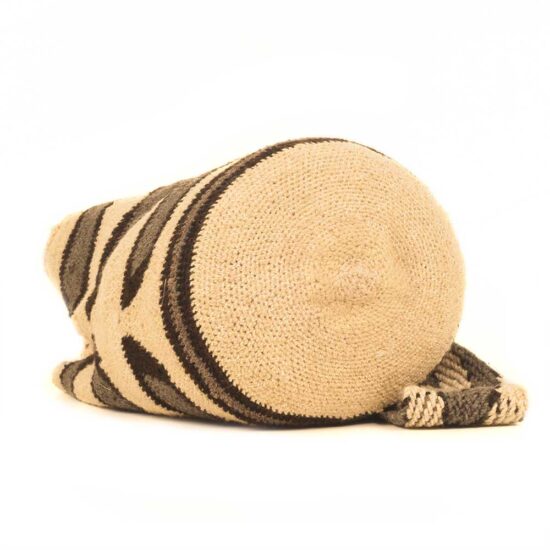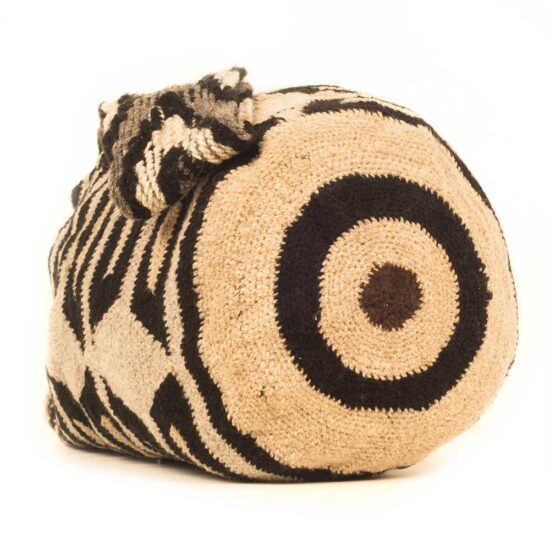Arhuacos
The Elder Brothers from Sierra Nevada de Santa Marta
At the beginning, the father-creator Kakü Serankua moulded Chundúa, the snow-covered peaks of the Sierra Nevada de Santa Marta mountains (Umunukunu in Iku, the language of the Arhuacos) – considered to be the heart of the world and the origin of life. He also created the first gods, and the first men – Hermanos Mayores (the Elder Brothers), and bestowed upon them the duty of protecting the earth.
The mountains are akin to their bodies, with the peak corresponding to their head, the lagoons below to their heart, the rivers and streams to their veins, the layers of soil to their muscles, and the scrublands to their hair. From that time onward, nature and society were guided by Kunsamü, a sacred, pre-existent, universal law that aims to preserve equilibrium and harmony among all things.
The Tairona Culture
Today, Sierra Nevada, the pyramid-shaped mountain range on the northern tip of the Andes, still rises to over 5,000 meters in altitude. Located only 26 miles from the Caribbean coast of Colombia, it is home to around 20,000 members of the Arhuaco ethnic group and three other tribes.
These people are all descendants of the ancient Tairona culture that ruled this area, developing an intricate socio-political system of chiefdoms, with a complex economy comprising the coastal fisheries and farms, the mountainous grazing lands, and the inland gold mines, which were connected via a network of stone-paved roads that provided trading routes for burgeoning commerce.
The History of the Arhuaco People
Arhuacos, as well as the other tribes of the Sierra Nevada, have retained the tradition of Hermanos Mayores, and believe that whatever happens within their privileged microcosm affects the rest of the world. Therefore, they make sure that order and harmony is preserved by carefully observing the law, making ritual offerings at ancient sites, performing dances, and meditating to gain a better understanding of the rhythms of nature.
Their territory has shrunk – in the mid-17th century the Tairona, after generations of defiance, surrendered to the Spanish conquerors, and their culture mostly perished. The land became occupied by new landowners, and the remaining tribesmen fled higher up the mountains to avoid confrontation with their Hermanos Minores (the Younger Brothers) – the name given to outsiders by the Hermanos Mayores.
However, they were soon to discover that the menace of their siblings was to worsen. They faced forced labor and Christianisation at the hands of the Capuchin Friars, which made them abandon their settlements in an attempt to preserve their old ways. Their land was expropriated in favour of state-owned agricultural farms, while TV transmitters were built on top of their sacred mountains.
In the 1980s, the Hermanos Mayores were caught in crossfire with the Colombian Armed Conflict, a time when many of their old lands became plantations of marijuana and cocaine, and the different factions of the drug war started fighting for the control of the area.
Recently, the integrity of their ecosystem has been threatened by huge projects to construct dams and hydroelectric plants, and intensifying tourism.
Poporo – The Mark of a Man
To the present day, the tribes make all of their clothes. Most importantly, tutosoma, the conical white hats made of agave fibers, symbols of manhood that represent the snowy peaks above their heads. These are given to a young tribesman at a certain period of adolescence, as a mark of maturity, together with the paraphernalia used to carry the coca leaves. The most important of those is the iconic poporo (or yoburu in Ika) – a hollowed-out gourd that contains crushed snail or seashells.
The second part of the instrument constitutes a stick used to transfer the powder to the mouth, where it is mixed with the wad of coca – releasing the active alkaloids. On top of being symbols of maturity, responsibility and knowledge, poporo also represents the unity of man (the stick) and woman (the gourd). Finally, there is Zizhu, one of the three bags normally worn by Arhuaco man, which is used to store the coca leaves. Zizhu bags are fundamental items of the Arhuaco culture and a reflection of their world vision and values.
Serankua made the world by circling over the ancestral lands in a spiral movement, drawing the shape of a snail’s shell (Urumu, the snail, also symbolises the beginning, unwinding of time), sowing his sons into the earth wherever he passed.
This is how the Arhuaco women view their Tutu iku, the cross-body bags.Tutu iku are as much a token of femininity as the poporo is of masculinity – the first bag a girl knits is brought to Mamo, at the time of her first menstruation, to be used in initiation rituals that affirm her entry into the group of mature women (Wati).
In her life she will make many more – to exchange them for paper money or products that can’t be produced by the community – not more though than six or seven per year, as each bag may take as long as two months to elaborate. However, the most important mochila bags are those she will weave for her husband or her son.
The Arhuaco bag (mochila)
Above their utilitarian value, the knapsacks are saturated with multilayered cultural code. Similarly to the bags made by the Wayuu people, they encapsulate the tribe’s cosmology and cosmogony. Each time a woman makes a bag, she becomes Mother Earth – her forces of fertility are unleashed, reenacting the original act of creation.
The mochila is a manifestation of symbolic objects from the tribe’s surroundings, as well as their mythology – all of this is expressed, not only in the bag’s pattern, but also in it’s intricate geometry, where all it’s measurements, the height, the diameter and the length of the strap, hint at the individual’s and the group’s position in the universe.
The weaved figures (26 in total, according to scholars) represent totemic animals, including rattlesnakes, scorpions, ants and owls, and sacred elements of the environment such as the snowy peaks (phundawas) or the hills and lakes (gwirkunu), essential abstract concepts, for instance, human thought (kunsamunu cheyrua), the four directions of the world (chinuzatu), and, at times, the creator Serankua himself.
Except for occasional, commercially-driven compromises taken contemporarily by Arhuaco women, the weaver never designs the pattern on the bag, but rather realises one from the traditional symbolic repository.
It is also believed that each Wati is only spiritually capable of weaving certain figures and she normally limits her work to those. Notably, the colours of the treads, earthy tones of grey, brown, beige and black, also play an important role. Their combinations and alterations provide the rhythm and structure of the design.
Originally, the Arhuaco bags were made of agave or hemp (in the town of Atanquez), or fiber or cotton, but with the introduction of sheep by the Spanish in the 19th century, wool gradually became the material of choice. In the second half of the 19th century, the use of the bags started expanding beyond the Arhuaco territory, becoming popular among the urban youth as a way of making claim to their indigenous heritage. The tribe gained even more credence in the process of shaking off their colonial past when they expelled the Capuchins from their land in the 80s.
Today, Arhuaco bags are a very common sight on the streets of Bogotá, Medellín and Cartagena, and, together with sombrero vueltiao, have become an icon of Colombia in general.
The Arhuaco Society Today
The Arhuacos have adapted to their new reality by finding alternative ways of sustenance and forming the Confederación Indígena Tairona, a political organisation aiming at defending their values and land. The younger generation is learning Spanish to be enable them to interact with their Younger Brothers and express their point of view.
Contrary to other tribes of the Sierra Nevada, they also developed written documents in Ika, their native tongue, and founded schools to make sure that their language and culture are authentically preserved for the future. The core of their philosophy and social structure remains largely intact.
They still travel down to the invisible “black line” that once demarcated their territory and where many of their ancestors’ sacred sites are located, performing rituals and laying down offerings, according to their belief that the earth needs to be given back what has been taken out of it more than ever. They also continue to meticulously select their Mamos – spiritual authorities and head tribesmen, which are chosen as young boys and trained by the elders for a minimum of nine years.
They are key figures of Arhuaco society, intermediaries between the celestial forces and the men, custodians of the Kunsamü law that act as judges, priests, doctors and counsellors, and have a key influence in any decision that affects their brethren.





